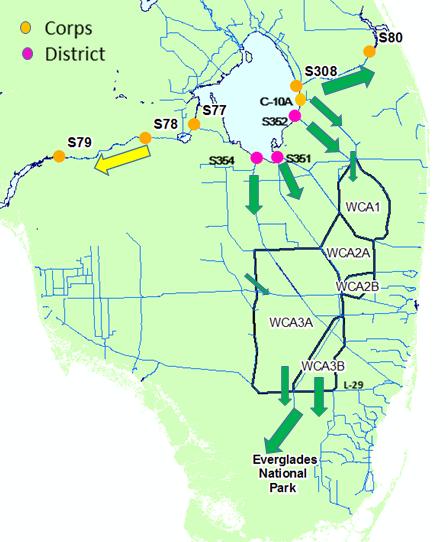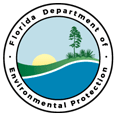|

FOR IMMEDIATE RELEASE: May 13, 2016
CONTACT: DEP Press Office, 850.245.2112, DEPNews@dep.state.fl.us
DEP'S DAILY UPDATE ON LAKE OKEECHOBEE
In an effort to keep Floridians informed of the state’s efforts to protect the environment, wildlife and economies of the communities surrounding Lake Okeechobee and the Caloosahatchee and St. Lucie estuaries, the Florida Department of Environmental Protection is issuing a Lake Okeechobee status update each weekday. These updates will help residents stay informed of the latest rainfall and lake level conditions, as well as the latest actions by the State of Florida and U.S. Army Corps of Engineers.
Latest Actions:
- By raising the L-29 canal level, per an order from the U.S. Army Corps of Engineers and at the request of Governor Rick Scott, the South Florida Water Management District has been able to move approximately 67.0 billion gallons of clean water into the northern portions of Everglades National Park, as of midnight on May 12, 2016.
For more information about the State of Florida's actions on Lake Okeechobee, click here.
Lake Conditions:
|
Current Lake Level
|
13.78 feet
|
|
Historical Lake Level Average
|
13.32 feet
|
|
Total Inflow
|
1,640 cubic feet per second
|
|
Total Outflow
(by structures operated by the U.S. Army Corps of Engineers)
|
5,530 cubic feet per second
|
|
Evapotranspiration
|
4,580 cubic feet per second
|
|
Net
|
-8,140 cubic feet per second
|
|
Lake level variation from a week ago
|
-0.30 feet
|
Lake Okeechobee Management Information:
|

The figure above depicts various flood control structures that the U.S. Army Corps of Engineers (Corps) and the South Florida Water Management District (District) operate. The arrows illustrate the direction of water flow. The yellow arrow indicates discharges that are at levels that allow for salinity to increase, but only into the fair range. The green arrow to the right of the lake indicates discharges that allow for salinity to increase into the good range. The green arrows south of the lake show the movement of water to the Everglades Agricultural Area, and the movement of water from the water conservation areas into the L-29 canal to avoid potential ecosystem impacts at Everglades National Park. The district began this movement on Feb. 15, 2016, after receiving an order from the Corps at the request of Governor Scott.
|
|
Structures
(see map above)
|
Federal Release Guidance
(based on 2008 Lake Okeechobee Regulation Schedule)
|
Daily Average Releases
(based on the U.S. Army Corps' C&SF System Status Update as of midnight 5/12/16)
|
|
East – S-308 (operated by U.S. Army Corps of Engineers)
|
N/A
|
410 CFS
|
|
East – S-80 (operated by U.S. Army Corps of Engineers)
|
Up to 950 CFS
|
370 CFS
|
|
West – S-77 (operated by U.S. Army Corps of Engineers)
|
Up to 2,500 CFS
|
1,730 CFS
|
|
West – S-79 (operated by U.S. Army Corps of Engineers)
|
N/A
|
1,300 CFS
|
|
South - 3 structures (operated by South Florida Water Management District)
|
N/A
|
3,160 CFS
|
|
The table above depicts the guidance for releases from the lake based on
the Corps' 2008 Lake Okeechobee Regulation Schedule as compared
to the actual daily average releases.
|
Salinity Conditions:
Caloosahatchee Salinity Conditions: Salinity (based on optimal conditions for adult oysters) is in the good range at Shell Point and in the fair range at Cape Coral.
St. Lucie Salinity Conditions: Salinity at the U.S. 1 bridge and A1A is within the good range.
Florida Fish and Wildlife Conservation Commission's Wildlife Update:
The FWC continues to monitor water levels and the status of wildlife in three Wildlife Management Areas (WMAs) in South Florida within the Everglades ecosystem. The three areas, Everglades and Francis S. Taylor WMA, Holey Land WMA and Rotenberger WMA, encompass 736,881 acres. These WMAs provide important habitat for a diversity of imperiled wildlife species, including the Everglades snail kite, Everglades mink, little blue heron, tri-colored heron, snowy egret, white ibis, wood stork and limpkin, as well as native and abundant species like American alligators, white-tailed deer and marsh rabbits.
- FWC’s monitoring efforts include periodic wildlife and habitat surveys. FWC staff continues to watch water gauges to monitor high water levels and the impacts and stresses they may be having on areas like the Everglades tree islands, which are critical to the survival of Florida wildlife species. High water levels can seriously impact nesting and feeding activities of our native birds and make large and small mammals much more vulnerable to disease, starvation and predation. The condition of habitat on tree islands is an important indicator for the level of stress being experienced by wildlife.
- Water levels remain lower than they were a week ago. Current water conditions are as follows:
Everglades WMA:
- Water level (average of 62/63 gauges) as of May 12 = 10.26 feet
- High water closure criteria = 11.60 feet
- Regulation schedule = 9.63 feet
- Average for this time of year = 9.52 feet
- Recession rate for the last week = -0.05 feet
- Water level trend over the past 3 weeks = dropping
Rotenberger WMA:
- Water level as of May 12 = 12.38 feet
- High water closure criteria = 13.50 feet
- Regulation schedule = 12.25 feet
- Average for this time of year = 11.61 feet
- Recession rate for the last week = -0.04 feet
- Water level trend over the past 3 weeks = dropping
Holey Land WMA:
- Water level as of May 12 = 11.37 feet
- High water closure criteria = 12.50 feet
- Regulation schedule = 11.00 feet
- Average for this time of year = 10.53 feet
- Recession rate for the last week = -0.07 feet
- Water level trend over the past 3 weeks = dropping
Water levels at the WMAs are still approximately 0.75 feet above normal. A continuing decrease in water levels prior to the upcoming wet season, which starts mid-May to June, will help ensure that desirable conditions will exist for next year's wading bird nesting season.
Wildlife surveys conducted on WMA levees and tree islands during the past week suggest use by wildlife has continued to decrease as a result of receding water levels in all of the WMAs. Typically this time of year (five months into the seven-month nesting season), we observe increased wading bird nesting, but so far, only very limited nesting and foraging has been observed. Wading bird and snail kite nesting numbers have remained limited and unchanged during the past several weeks.
Members of the public should report any distressed fish or wildlife to the following FWC hotlines:
- Wildlife Alert Hotline: 1-888-404-3922 or Tip@MyFWC.com
- Fish Kill Hotline: 1-800-636-0511
South Florida Water Management District's Rainfall Update:
Rainfall Information:
During the past three days, there has been no rainfall over the region.
Rainfall Forecast:
Warm with some limited shower activity. A cold front currently over Texas is forecast to move into Florida’s Panhandle today and then weaken as it pushes into South Florida on Saturday. Dry air remains over the area so daytime heating should squeeze out only some widely scattered showers mainly over the interior this afternoon. Moisture is expected to increase ahead of the approaching cold front and produce scattered shower activity focused over eastern areas. As the front moves into the southern portion of the district and becomes diffuse, dry air will filter back over the area so only some spotty shower activity is expected south on Saturday and Sunday afternoons. Breezy east winds will bring a return of moisture on Monday and allow some scattered afternoon shower activity mainly over the interior on Monday afternoon.
More information about the State of Florida's actions on Lake Okeechobee:
- On April 29, 2016, the special regulations that limited public access on the Everglades and Francis S. Taylor, Rotenberger and Holey Land WMAs were rescinded. Criteria for rescinding the special regulations are a combination of water levels and wildlife observed on surrounding levees.
- On April 28, 2016, Governor Rick Scott sent a letter to Brigadier General C. David Turner of the U.S. Army Corps of Engineers requesting continued authorization for increased water levels at the L-29 Canal in Lake Okeechobee.
-
On April 20, 2016, the South Florida Water Management District (SFWMD) received two permits from the U.S. Army Corps of Engineers that will allow the District to plug the L-28 tieback canal and use the existing S-344 water control structure on the west side of the water conservation area to move up to 300 cubic feet of water per second into the Big Cypress National Preserve.
-
The permits were expedited in response to Gov. Rick Scott's previous emergency request – allowing the District to deviate from its previous water control schedules.
- This is an additional strategy taken by the SFWMD and the State of Florida in response to unprecedented dry-season rainfall that has filled Water Conservation Area 3A above its regulated levels. This will allow the SFWMD to move even more water south and west out of the conservation area into the Big Cypress National Preserve, improving flood control throughout the system and protecting wildlife habitat in the conservation area.
- The South Florida Water Management District has responded to record dry season rainfall by moving billions of gallons of clean water to relieve high water levels in two critical locations. This unprecedented response includes:
- Water managers began emergency operations on Feb. 15, 2016, to move water from the vast wetlands in Miami-Dade and Broward counties to Everglades National Park. The record rainfall left water levels too high for Everglades wildlife in WCA-3.
- Through mid-April, SFWMD water managers have moved 51.7 billion gallons of clean water from WCA-3 into Northeast Shark River Slough in Everglades National Park.
-
On Feb. 26, 2016, Governor Rick Scott signed Executive Order 16-59, which declares a state of emergency in Lee, Martin and St. Lucie counties, following heavy rainfall that has resulted in the U.S. Army Corps of Engineers frequently discharging water from Lake Okeechobee to the St. Lucie and Caloosahatchee estuaries. This is a result of inadequate funding by the federal government. Governor Scott called on the Obama Administration to fully fund the more than $800 million in needed repairs to the federally operated Herbert Hoover Dike to safely hold water to prevent these discharges. To view the Executive Order, click here.
- On Feb. 11, 2016, Governor Rick Scott requested that the U.S. Army Corps of Engineers take immediate action to relieve flooding of the Everglades Water Conservation Areas and the releases of water from Lake Okeechobee to the Caloosahatchee and St. Lucie estuaries. Click here to read the letter.
- The Florida Department of Environmental Protection and the Florida Fish and Wildlife Conservation Commission (FWC) issued orders on Feb. 11, 2016, that would allow the U.S. Army Corps of Engineers to move forward with this request. Click here to read the orders.
-
On Feb. 15, 2016, the U.S. Army Corps of Engineers agreed to Governor Scott’s request to raise water levels in the L-29 canal in order to move water south through Shark River Slough to ease the effects of flooding in the Everglades. The South Florida Water Management District began operation of the S-333 structure at 5:30 p.m. on Feb. 15, 2016, after the state received an order from the U.S. Army Corps of Engineers.
|



